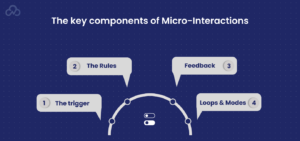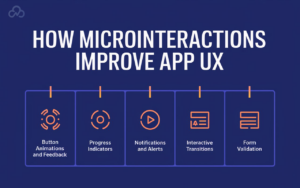Introduction
As capable as we are at making handsome advances in mobile apps and sites, contemporary digital products success or failure now rests on the ability to provide best user experience (UX). Microinteractions play a prominent role in thinking about what is required in order to construct an intuitive and pleasant UX. Microinteractions, in spite of their minimal expression, considerably enrich your app’s experience with them helping you provide an intuitive, engaging, and effective navigation process for your users.
Here in this article we’ll talk about microinteractions, significance of the same in the current day’s as well as how through these micro design elements, UI/UX design firms can measure up to raise the level of satisfaction of app users. Whether you’re building an app or redesigning an existing one, understanding how microinteractions work can take your product to a whole new level of user experience, particularly in a busy marketplace.
What Are Microinteractions?
Microinteractions are small, barely noticeable operations of a user interface (UI), that help users interact with the product. Users generally trigger these actions with their activities, such as button clicks, swipes or arrival of notifications. Examples included a change of a button’s color after a click, and a light animation that pops up after a task is completed.
Though they seem mundane, microinteractions are essential to making an app more usable, interactive, and aesthetic. These subtle qualities assist users in navigating tasks, inform users of actions and add a sense of ownership when using the app’s interface. After all, these tiny moments inject into users’ happiness and engagement to make the experience more enjoyable.
Why Microinteractions Matter in UI/UX Design

Beyond its appearance, microinteractions provide real value to the functional aspect of user journeys. They help deliver satisfaction to users when using your product. There are a number of crucial reasons, why microinteractions are so important to a good UI/UX design.
Making Users Aware of How to Engage with the App
A critical role of microinteractions is to guide users using the app to get around by providing clear instructions. When your users browse through your app, they use visual cues of how to use different components. Starting with a simple animation that suggests button interactivity, to progress tracking in a progress bar, microinteractions provide clear feedback to guide users along the task flow.
Improving Usability and Efficiency
Providing immediate responses, microinteractions assist users to know better on how to deal with your app. An example of this is how the time a user puts an item on the shopping cart, a small visual hint such as a small animation or update to the cart sign can act as a confirmation for the action having been completed successfully. Such instant responses prove that the action is already done and contribute to the smooth flow avoiding the misunderstandings or irritation of the user.
Creating Emotional Engagement
Slightly, but microinteractions affect the users greatly emotionally, or am I mistaken? Creature comforts in form of visual cues done in appropriate manner using animations or effects can withdraw positive emotions such as delight, satisfaction, or surprise. For instance, an interactive unlock animation or a heart that softly ticks when someone likes a post will enable a more memorable and enjoyable experience with the app.
Enhancing Aesthetic Appeal
Microinteractions play a big role in beautifying your app’s visual layouts. The combination of seamless transitions, animated effects and visually impactful effects in microinteractions contributes to the creation of uniform and refined design look. When an app radiates an aesthetically pleasing design, users will patronize its app more by staying in the said app marveled by its elegance.
Increasing App Engagement
Interaction with microinteractions on the app also means the users spend more time in the app and they are more involved. With the addition of visual feedback, dynamic animations, and advancements in tasks to apps, they engage more people hence increasing the chances of users coming more often. Boosting user engagement is very important for the apps in the long run.
How Microinteractions Improve App UX

To learn how UX can be made better with the help of microinteractions, you should take a look at how we actually put them into applications. Let’s have a look at some of the most common examples of microinteractions that can significantly improve app usability:
Button Animations and Feedback
Microinteractions within your app quickly show visual notifications to the users whenever they click a button or when they perform a certain action. A button press is responded to by a minimalistic adjustment in size, update in color, or realistic “push” effect that makes the experience more interactive. By adding these mini-interactions, your app becomes more interactive to make the users not feel too frustrated in completing routine tasks.
Progress Indicators
Regularly, apps will be seen to show progress bars or loaders to indicate that processes are in function. Such updates can be rudimentary, but if you add smooth movements to them, or change the nuances, you can attract a user’s attention while they observe the process. Since static progress bars are boring for users and do not make progress feel interactive in any way, adding animated micro interactions to a static progress bar is a great idea.
Notifications and Alerts
With microinteractions, notifications and alerts are more noticeable and thus draw user’s attention. A notice could softly pop up onto the screen, flicker a bit to draw notice, or change in color to emphasize importance. Such animated cues are mild reminders of long-waited for notifications which do not flood the user.
Interactive Transitions
When applied, movement between screens becomes a smoother and more natural process. This includes transition options such as fading or sliding or zooming and is what gives users a feeling of smooth control over the app’s interface. Communicating smooth transitions between screens helps stop abrupt changes that may interrupt the course of a user through the application.
Form Validation
Many users complain about form completion issues as they do not know if they have properly filled in the forms. Through microinteractions, the app can notify a user moment they enter something wrong, enabling the correction of mistakes fast. The case which is where the input area turns red and fades in and out, or it shows an error message near the field. Such cues help users to rectify their errors in good time and improve overall satisfaction with the app.
How UI/UX Design Services Leverage Microinteractions
The eternal UI/UX design services are in the reconciling of the microinteractions into the design that enhance usability, without causing user fatigue. Skilled design agencies are able to skillfully work with microinteractions to improve and improve app usability.
Customizing Microinteractions for Your Brand
UI/UX designers will personalize your app’s microinteractions in order to reshape the personality and tone of your brand. UI/UX design services make two subtle changes in the style of microinteractions to conform to the brand’s character and seductiveness: a lighthearted app might use fiery animations, whereas sharp, restrained gestures are appropriate in a serious platform.
Optimizing for User Flow
The cornerstone of successful UX design touches on creating a smooth user experience. Designers work on bringing each micro interaction in line with the wider picture of where the user experience is. For instance, designers may utilize microinteractions either to emphasize critical steps or to lead users from the path of possible errors. To help enhance the experience and make the app more usable, the user journey is being stressed to these microinteractions.
Ensuring Consistency
Consistency is a core element in UI/UX design and much more important when it comes to microinteractions. Through the use of UI/UX design services, all microinteraction will follow the same style, behavior, and time within the application. This makes the all-round app more in terms of understanding and use for users.
Testing and Iteration
A specialized UI/UX design service would carefully test microinteractions to verify their efficiency and make sure that they work for the good of the app’s interface. As users engage the microinteractions, feedback is recorded to guide subsequent changes to realize a more effective experience.
Mobile Optimization
Mobile optimization is a crucial element of UI/UX design services dealing with microinteractions because users expect a flawless and speedy amity with the help of their device. Making animations fast and interactive elements’ access easy to use brings the success of achieving the fluid user experience across mobile platforms.
FAQs
1. What are microinteractions in UI/UX design?
They are talking about small, usually overlooked actions in an interface that respond to user gestures, i.e. tapping, scrolling, or notification. Slight changes that include animations, response signals, and informative messages provide more fluid, colorful, and applicable interactions that turn the app into something that feels more user friendly and effective.
2. Why are microinteractions important for app UX?
The major importance of microinteractions is that they guide users from actions, provide fast feedback, and create a personal relationship between the user and the app. When making the app more intuitive, faster and more interactive, microinteractions contribute toward bettering usability, definitions of tasks, and user satisfaction. Even these apparently small points are capable of increasing overall satisfaction of users by a large margin.
3. How can UI/UX design services implement microinteractions effectively?
Effective microinteraction design is realized through UI/UX services that make sure these aspects reinforce the brand of the app and the user story. Designers ensure that these interactions are uniformly structured, intelligible and visually appealing. Collecting and acting on user feedback enables design services to tweak these components and deliver a smoother, more enjoyable process for users.
4. Can microinteractions slow down app performance?
App performance shouldn’t be noticeably affected by correct implementation of micro interactions. Fast and smooth design in microinteractions makes it possible for animations and response to better usability without introducing delays. However, failed optimization or visual optimization abuse may hamper performance, and for that reason, UI/UX specialists insist on finding a balance between usability and visual display.
Conclusion
Microinteractions can be an easy way to optimize an app’s design and create a much more powerful user experience, which will encourage a user to keep using the app and make the process of making a purchase more enjoyable. Pay attention to the slightest aspects of your design to enable users to finish tasks gaadly, provide instant feedback and to physically connect to your users. Professional UI/UX design can assist you to seamlessly blend these micro interactions into a finished product that is both enhanced and user friendly.
In order to increase the user experience of your app, use UI/UX design services to considerfully implement microinteractions that make the overall experience better. Many times, it is the small things in your app that create user satisfaction.
Do you like to read more educational content? Read our blogs at Cloudastra Technologies or contact us for business enquiry at Cloudastra Contact Us.